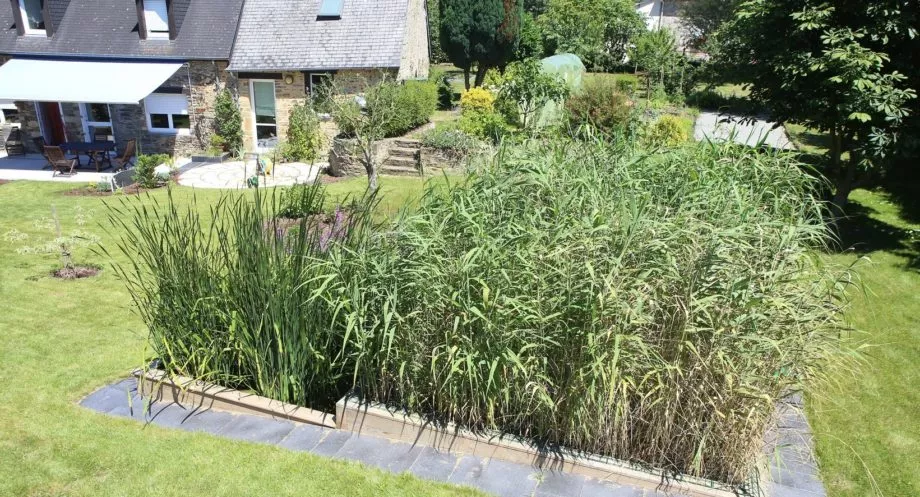Is phyto-purification also suitable for second homes?

Phyto-purification, a method of treating wastewater that exploits the natural abilities of microorganisms sheltered within plants to filter wastewater, is increasingly establishing itself as an ecological alternative to traditional sanitation systems. But what about its compatibility for second homes which are often used intermittently?
Understanding phyto-purification
Before assessing its suitability for second homes, it is essential to understand how phyto-purification works.
Phyto-purification is a set of natural wastewater treatment techniques using plants. More specifically, it is a method of wastewater treatment that relies on a combination of microorganisms and plants in an ecosystem specially designed for this purpose. The principle behind phyto-purification is simple: a plant filter is created to collect wastewater from homes.
The wastewater from the home arrives on the surface of the filter which is planted with reeds. The role of the reeds is mainly mechanical: the development of the stems and rhizomes maintains the permeability of the filter over the long term, and the roots as a whole harbour an ecosystem that is very rich in bacteria and other micro-organisms. The reed filter is divided into two parts that are fed alternately. The upper layer of the filter is made up of sand which acts as a sieve, retaining solid matter on the surface of the filter. This matter will quickly compost while the water passes vertically through the entire filtering bed. The bacteria present in the filtering bed will digest the pollution and the water continues on its way to the infiltration zone.
Benefits for second homes
For second homes, wastewater management can be a real headache, especially when usage is irregular. Fortunately, phyto-purification offers a simple and effective solution. Adapted to variations in usage, economical to use and environmentally friendly, this natural method of wastewater treatment has it all.
Flexibility and resilience
One of the main advantages of phyto-purification for second homes is its ability to adapt to significant variations in load. Unlike conventional sanitation systems, which can be inefficient or costly to maintain when the flow of wastewater fluctuates, phyto-purification works effectively even when loads are irregular. Whether the residence is unoccupied for long periods or at full capacity during the holidays, the system adapts without compromising the quality of the treatment.
Reduced operational costs
For owners of second homes, reducing operational costs is often a priority. Phyto-purification requires only minimal energy input, as it relies mainly on natural processes. This translates into savings on energy and maintenance bills. In addition, phyto-purification systems have a long lifespan and require little technical intervention, further reducing costs in the long term.
Positive environmental impact
Second homes are often located in rural areas where the preservation of the local ecosystem is important. By using phyto-purification, owners can minimise their ecological footprint while ensuring effective wastewater treatment. Phyto-purification systems not only avoid the use of harsh chemicals, but also contribute to local biodiversity by providing a habitat for plants and wildlife.
Considerations for installation
Soil study
Before considering the installation of a phyto-purification system, it is essential to carry out a soil study. This analysis must not only assess the nature of the soil, determining its composition, but also take into account the topography of the site, which can influence the flow of water and the efficiency of the system. The specific wastewater treatment requirements are also examined as these may vary from one site to another. The results of this study are used to guide the design of the system. This includes the configuration of the planted filter which must be adapted.
Maintenance and monitoring
Although phyto-purification requires little maintenance, good maintenance not only ensures the longevity of the system, but also its continued effectiveness.
Conclusion
In conclusion, phyto-purification is particularly suitable for second homes thanks to its flexibility in the face of variations in load, its low operating costs and its positive environmental impact. It offers an environmentally friendly alternative to traditional sanitation systems. What’s more, opting for phyto-purification in a second home is not only a practical and reliable solution, it is also a choice that is part of a sustainable and responsible approach. Owners can thus enjoy their holiday home without worrying about the constraints of sanitation, while contributing to the preservation of the environment.
In short, phyto-purification for second homes is much more than just a technical solution. It is a step towards a more environmentally friendly lifestyle, combining personal comfort and ecological responsibility, while actively contributing to the preservation of the local environment.

